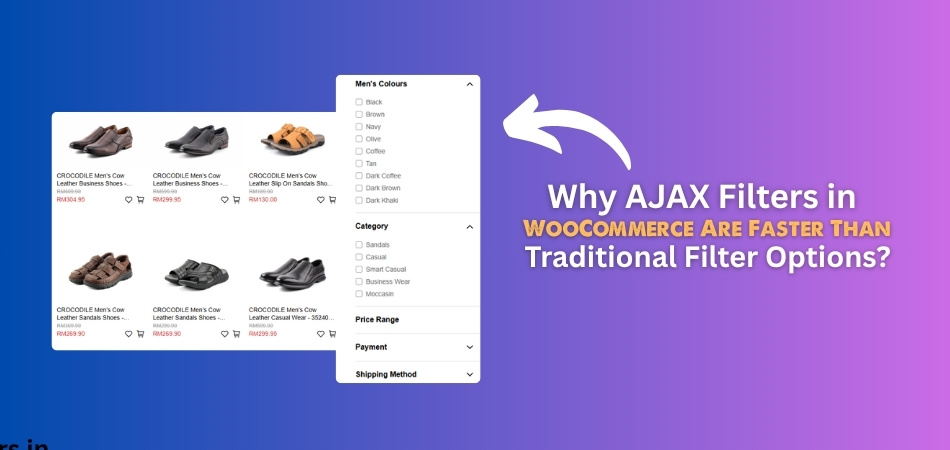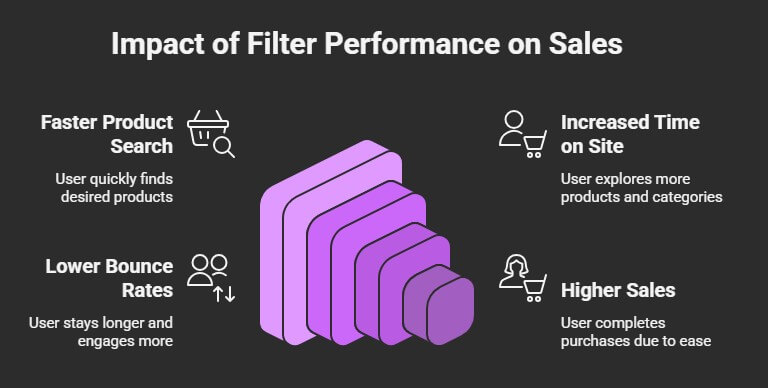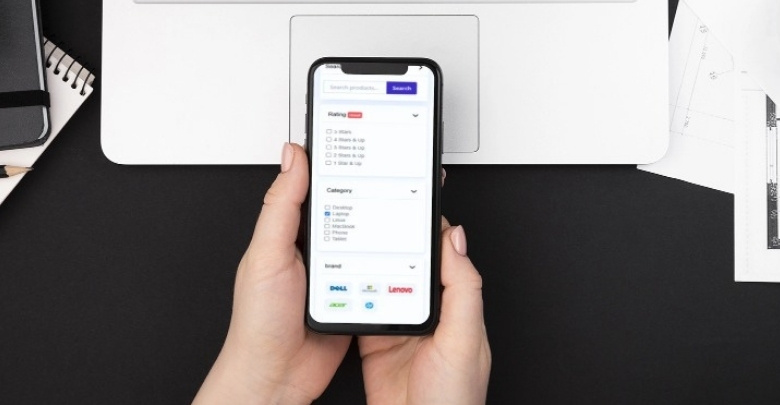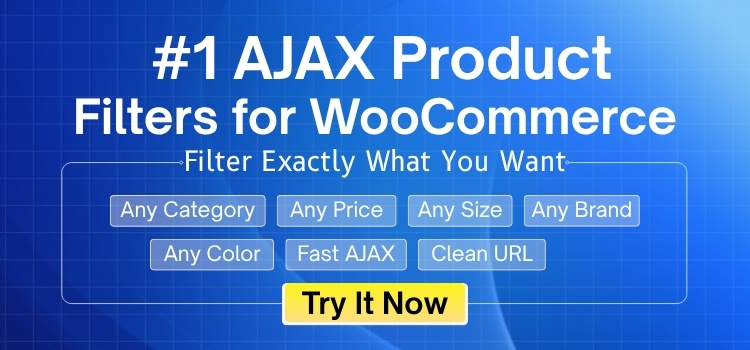WooCommerce shops should feel smooth, fast, and easy to use for shoppers. They enjoy a better experience when pages load quickly and filters work without delay. That’s where AJAX filters come in. They help load filtered products faster, without reloading the entire page. Now you might be thinking: Why AJAX filters in WooCommerce are faster than traditional filter options?
AJAX Filters in WooCommerce are faster than traditional filter options because they update only the filtered products without reloading the entire page. This speeds up the process, reduces server load, and creates a smoother user experience. Customers see instant results, making it easier to shop, especially in stores with large product catalogs.
Do you want to know more about how AJAX filters actually work? If so, then keep reading. You’ll find everything you need to know about this topic right here in this article.
Why AJAX Filters in WooCommerce Are Faster Than Traditional Filter Options?
Using filters while online shopping can help you find what you’re looking for faster. WooCommerce uses something called AJAX Filters, which work differently from older filter options. But what makes AJAX Filters so special and faster than traditional filters? Look below to know about it:

What Are AJAX Filters?
AJAX (Asynchronous JavaScript and XML) filters allow product filtering on WooCommerce stores without requiring a full page reload. When a user applies a filter (e.g., price, color, size), the filtered results are dynamically loaded using background server requests. This results in faster responses and a more seamless user experience. AJAX filters improve performance by updating only specific parts of the page instead of reloading everything. They are especially helpful in large catalogs where quick filtering improves navigation and user satisfaction.
What Are Traditional Filters?
Traditional filters in WooCommerce rely on full-page reloads to display filtered results. When a user selects a filter option, the entire page refreshes to show updated product listings. This method is slower because it reloads all elements, including those that haven’t changed (like the header and footer). It can interrupt user flow and feel less modern and interactive compared to using a WooCommerce ajax product filter, which provides a smoother, faster experience. Below is a detail about why AJAX filters in WooCommerce are faster than traditional filter options:
No Full Page Reloads
Traditional filters refresh the whole page every time you choose a new option, like color or size. This takes more time because the entire webpage has to load again. AJAX filters skip all that and only update the products section. That means everything else on the page stays the same, saving time and effort. This makes the shopping experience smoother and faster.
Less Work for the Server
When a full page reload happens, the server has to send back everything—the layout, images, scripts, and more. But with AJAX, only the product details are sent, which is a much smaller amount of data. This lighter load makes the server respond quicker. It also helps during busy times when lots of people are shopping at once. So, the site doesn’t slow down as much.
Uses Browser Memory
Some AJAX filters save data right inside your browser. So, after the first time you use a filter, the next filter change can happen instantly. This happens because the site doesn’t have to ask the server again for the same info. It’s like remembering where something is kept, so you don’t have to go looking every time. This makes filters feel lightning fast.
Better for Shoppers
Nobody likes waiting for pages to reload over and over again. With AJAX filters, the results update right away, which keeps things quick and fun. Shoppers can easily try different options and see what they want without getting bored. This makes them more likely to keep browsing and even buy something. A fast site makes happy shoppers.
Handles Big Stores
Some online stores have thousands of products, which can slow things down with traditional filters. AJAX filters solve this by loading only the parts that are needed. Instead of reloading every single item, they fetch just what matches your filter. This keeps things fast, even in stores with huge catalogs. So no matter how big the store is, the filters still work quickly.
That’s how AJAX filters make WooCommerce sites faster and better to use. They keep things smooth, save time, and give shoppers a much nicer experience.
Traditional vs. AJAX Filtering: What’s the Difference?
Choosing the right filter system can make a big difference in how fast and easy your online store feels. Traditional and AJAX filtering work in different ways, each with its own pros and cons. Here’s a quick look at how they compare across important aspects:
| Aspect | Traditional Filtering | AJAX Filtering |
| Setup Complexity | Easier to set up with basic features | Slightly more complex, often needs a plugin or custom setup |
| Design Flexibility | Limited control over how filters appear and behave | More flexible design and layout options |
| SEO Benefits | Sometimes better for search engines due to full page URLs | Needs careful setup to avoid SEO issues |
| Loading Animation | No visual feedback during loading | Can show spinners or animations while loading |
| Customization | Harder to change filter behavior without full reload logic | Easier to customize filtering behavior without reloads |
| Plugin Support | Fewer plugin options available | Many WooCommerce plugins support AJAX filtering |
| Real-Time Updates | Doesn’t support real-time updates | Can update filters and results in real time |
| Error Handling | Page reload hides small errors | Can show instant messages for errors (like no products) |
| Scroll Position | Scroll resets after reload | Keeps the scroll position where it was |
| User Engagement | Less interactive filtering experience | Keeps users interested with faster and smarter filtering |
Why Does Filter Performance Matter for a WooCommerce Store?
Online shoppers want to find what they’re looking for easily. Filters help them do that by sorting products quickly and clearly. But if the filters are slow or not working well, it can mess things up. There’s a lot more to how filters affect an online store, so let’s break it down.

Faster Product Search
Good filter performance means shoppers can find the right product in just a few clicks. They don’t have to scroll through pages of items they don’t want. This saves time and keeps them happy. If filters are slow, people often give up and leave the site. Quick filters keep the shopping experience smooth and easy.
More Time on Site
Filters that work quickly tend to keep people on a site longer and attract more attention. They click on more categories, try different options, and explore products they might not have seen before. This can lead to more chances of them buying something. Slow filters, on the other hand, can make people lose interest. Keeping things quick keeps people engaged.
Lower Bounce Rates
Bounce rate means how many people visit a page and then leave right away. If filters take too long to load or don’t show the right results, people won’t wait. They’ll close the site and go somewhere else. A well-performing filter makes sure they stay and shop longer. That’s good for the store and the customers.
Higher Sales
When filters work fast, shoppers spend less time searching and more time buying. One of the biggest benefits of fast product filtering is that it removes confusion and helps people find what they want right away. This smooth experience makes them more likely to complete a purchase. On the other hand, slow filters can lead to frustration and lost sales. A fast and easy filtering system can quietly boost sales just by making shopping feel simple.
Smooth Mobile Shopping
Lots of people shop on their phones now. On smaller screens, filters need to be extra smooth and quick. If they’re not, the site can feel hard to use, and users might leave. Good filter performance makes shopping on phones just as easy as on a computer. That means more happy shoppers, no matter the device.
Better First Impressions
The first few seconds on a site really matter. If filters work fast, people instantly feel that the site is well-made and easy to use. Slow filters create a bad first impression, and many people won’t give it a second chance. Quick filters make the store feel modern and professional. A good first experience makes people want to come back.
What Happens When You Filter Without AJAX?
WooCommerce stores without AJAX filtering can feel slow and outdated. Each filter click reloads the entire page, which takes time and can be frustrating. Let’s break down what actually happens when AJAX isn’t used for product filtering.
- Full Page Reloads: Every time you choose a filter, the whole page reloads from scratch. This wastes time and interrupts the shopping experience.
- Increased Server Load: The server processes the full page again with each filter change. This creates more stress during busy shopping times.
- Slower Response Time: Since everything reloads, filters take longer to show updated results. Shoppers may get tired of waiting and leave.
- Lost Scroll Position: Each reload sends the page back to the top. Users must scroll down again, which feels annoying and repetitive.
- Reduced Mobile Usability: On phones, page reloads are extra slow and hard to use. This can push mobile users away from the store.
- Higher Bounce Rates: When filters feel slow, visitors are more likely to leave early. They’ll go find faster stores instead.
- Fewer Page Interactions: Shoppers click less when the site feels clunky. Fewer clicks usually mean fewer chances for sales to happen.
- No Real-Time Feedback: You can’t see instant results as you filter. That delay makes it harder to explore and compare products smoothly.
Is Adding AJAX-Based Filters to Your WooCommerce Store a Challenging Process?
No, adding AJAX-based filters to your WooCommerce store is not very hard if you use the right tools. Many filter plugins are easy to install and come with helpful guides. You don’t need to be a tech expert to get started quickly. Most of the setup steps involve simple settings and drag-and-drop options.
Some plugins work straight out of the box with your theme, so no coding is needed at all. You can choose what filters to show, like price, size, color, or tags. Many tools also let you style the filters to match your store’s look. One popular plugin that makes AJAX-based filter setups smooth and flexible is Dynamic AJAX Product Filters for WooCommerce, which is user-friendly for beginners.
Adding them is one of the easiest ways to reduce bounce rates with Ajax product filters, since shoppers get instant results. They stay longer because filters load results without refreshing the whole page. This makes browsing smoother, which keeps people from leaving early. You’ll also see more product views and possibly more sales without any extra effort.
Common Mistakes to Avoid With Your AJAX-Based Filters
Using AJAX-based filters can make your online store faster and easier to use, but things can go wrong if they’re not set up right. A few simple mistakes can slow things down or confuse shoppers. It’s not always about having the filters — it’s about using them the right way. Let’s look at what to avoid so your filters actually help your store.

Too Many Filter Options
Having too many filters can confuse people instead of helping them. If there are dozens of checkboxes, users won’t know what to pick. Keep things simple with the most useful filters only. A clean layout is easier to use and looks better as well. Try to guide users, not overwhelm them.
Poor Mobile Setup
Filters that look good on desktops might not work well on phones. If buttons are too small or the filter box doesn’t fit, people will leave. Make sure the filter layout adjusts nicely to different screen sizes. Mobile users should be able to tap and scroll with no problems. Always test your filters on both desktop and mobile.
Slow Filter Loading
AJAX filters are supposed to be fast, but a bad setup can still make them slow. Using too many scripts or a heavy theme can cause delays. Filters should update results in seconds, not several seconds. If they lag, people might give up. Fast filters keep people shopping longer.
No Clear Reset Option
Sometimes users want to start over, but if there’s no “clear all” button, they get stuck. This can be frustrating and lead to a quick exit. Always include a clear or reset button that’s easy to find. It helps users go back and try again without reloading the page. It’s a small detail that makes a big difference.
Not Testing Regularly
Filters can break after a plugin update or theme change. If you don’t test often, you might not notice until users start leaving. Click through your filters every now and then to make sure everything works. Fixing small bugs early keeps the shopping experience smooth. Don’t wait until someone complains.
Ignoring Filter Order
The order of filters matters more than you think. If the most-used ones are buried at the bottom, users might miss them. Put popular options like price, size, or brand at the top. This helps users find what they want quickly. Think of it like putting the best items on the front shelf.
Frequently Asked Questions
If you’ve been wondering how AJAX filters work or what they can do for your WooCommerce store, you’re not alone. Many people have questions about how these filters improve speed, user experience, and sales performance. Below are some frequently asked questions that haven’t been covered yet, each with clear and helpful answers to guide you further.
Can AJAX Filters Be Used With Custom Product Attributes?
Absolutely. Most AJAX filter plugins let you create filters based on custom product attributes like brand, material, or feature. This helps you offer more detailed filtering for unique products. It also gives your shoppers more control over what they want to see. Customization makes your filters more helpful and relevant.
How Do AJAX Filters Affect User Session Time?
Because users don’t have to reload the page each time they filter, they stay longer on your site. They’re more likely to keep trying different options and browsing more categories. This increases the average session time. The longer people stay, the better chance they’ll make a purchase.
Are AJAX Filters Useful for Niche WooCommerce Stores?
Yes, especially for niche stores where product differences are specific and detailed. Filters let users instantly narrow down to exactly what they’re looking for. AJAX makes this process smooth and engaging. Niche audiences often expect more precision, and AJAX filters deliver just that.
Can AJAX Filters Work Alongside Sorting Options?
Definitely. Users can apply filters and then sort results by price, popularity, or ratings without any reloads. It adds another layer of control while keeping things quick. Many plugins support both features. This makes shopping feel more efficient and flexible.
How Do AJAX Filters Handle Out-of-Stock Products?
You can set filters to hide or show out-of-stock items based on what works best for your store. This avoids wasting users’ time on unavailable products. AJAX filters apply this setting instantly without a page reload. It’s a smart way to keep users focused on what’s actually available.
Do AJAX Filters Require a Specific WooCommerce Theme?
No, most AJAX filter plugins work well with many themes. However, it’s always best to check compatibility or use well-supported themes. Some plugins even offer built-in styling that fits most designs. This makes them flexible and easy to use with your existing layout.
How Do AJAX Filters Impact Cart Functionality?
They don’t interfere with cart functions because filtering happens on the product listing side. Customers can still add items to their cart as usual. In fact, the smooth filtering might lead to faster cart additions. It makes the overall shopping experience more seamless.
Final Thoughts
Fast filters aren’t just a bonus—they’re what modern shoppers expect. When customers can quickly sort through products without refreshing the page, they stay longer and explore more. That’s exactly what AJAX filters help with.
If you’ve ever wondered why AJAX Filters in WooCommerce Are Faster Than Traditional Filter Options, it comes down to smart loading. Instead of reloading everything, they update only what’s needed. That saves time, reduces stress on your server, and makes your store feel more responsive.
Whether you’re running a small shop or managing thousands of products, smart filtering matters. Smooth, fast filters keep your visitors happy and ready to buy. So if you want to level up your store’s user experience, it’s time to switch to AJAX filtering.
